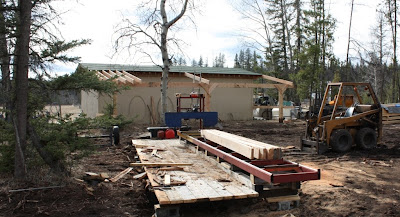Well they're pretty damn quick when one looks at the overall picture. The thing about it is that their little chippers go all the time and there are millions of them! Look at the pile of chipper dust that dwarfs these ants!

When the pine beetle outbreak was in its early stages, the experts in the forest industry felt they had 8 years to harvest this standing dead wood. Where we live, the forces of nature (ants, woodpeckers, fungi, and wind) can have a large pine tree on the ground within two years of needle drop.
 This huge tree . . . is still being supported (although tenuously)
This huge tree . . . is still being supported (although tenuously)

by this ant-eaten and woodpecker ravaged trunk!

So how come some old trees can stand for many years and these are falling so quickly?
I think there are a number of reasons . . . all to do with the pine beetle. The beetles deplete all the sap and resins in the tree and then emerge leaving holes. The tree has entry and exit holes all over the bark that are oozing pitch (candy to the ants) and providing an easy way to the interior wood for both ants and fungi.

Once the ants get started in the interior wood, the woodpeckers join the fray and shred the bottom of the tree looking for ants which drives the ants deeper and so it goes. Pretty soon it doesn't take much of a breeze to blow the tree down.

Even if the woodpeckers don't help, the tree can still be hollowed out in short order by the growing colony and again the wind helps.

Once its on the ground, the race is on to salvage anything usable out of the tree. The first few feet will be damaged by ants and fungi but then the rest of the log might be just fine.

Some trees snag up on another tree on the way to the ground. They pose a specially deadly hazard as they can unexpectedly domino other trees or release in the wind.

This is a place where the ants are way ahead in the race. Most of the trees here are already fallen and the forest is in the process of reclaiming them. So . . . that is the natural way and why not just let them fall and add to the forest humus and improve the fertility of the soil? That was certainly my attitude before the global warming or climate change crisis. This realization changed my mind . . . The carbon that is temporarily locked in these trees will all be released without our help within the next ten years as they rot and return to the ground.

If we harvest and process them, we can extend the time that this carbon is captured, by the life of the product we produce. and the more valuable that product is, the longer it is likely to remain a carbon sink.

Our
tiny piece of forest won't make much difference in the great scheme of things, but in the spirit of stewardship of what we have . . . we feel we must do our part.









 This huge tree . . . is still being supported (although
This huge tree . . . is still being supported (although 









 We reasoned that 14 feet would be sufficient width and at that, the run of the roof would allow us to raise the deck about 20 inches and still allow enough headroom to accommodate lifts of rough lumber for processing. With the planer in the center and doors at both ends, we should be able to handle normal lengths with the doors closed and longer lengths with them open.
We reasoned that 14 feet would be sufficient width and at that, the run of the roof would allow us to raise the deck about 20 inches and still allow enough headroom to accommodate lifts of rough lumber for processing. With the planer in the center and doors at both ends, we should be able to handle normal lengths with the doors closed and longer lengths with them open.



